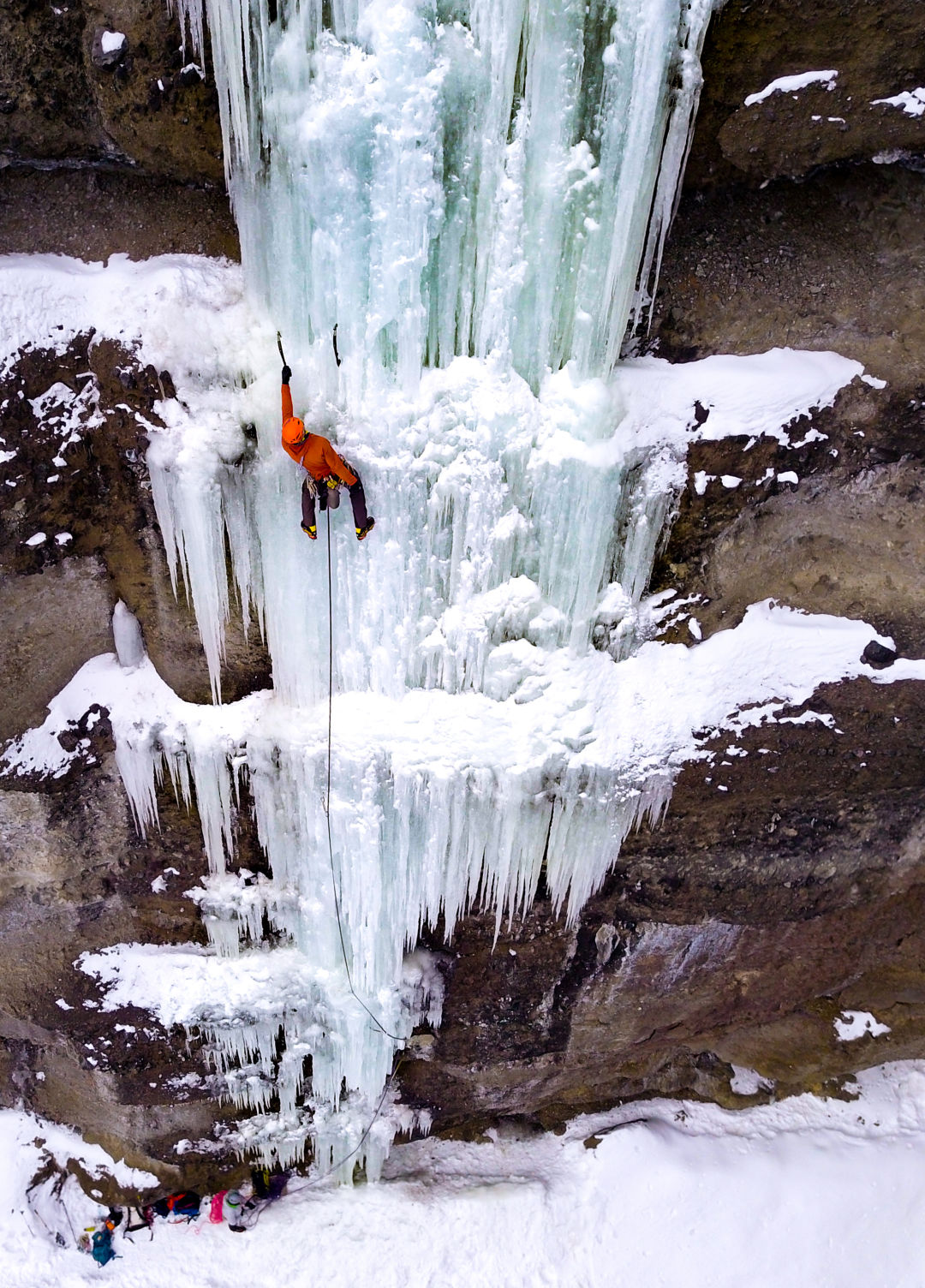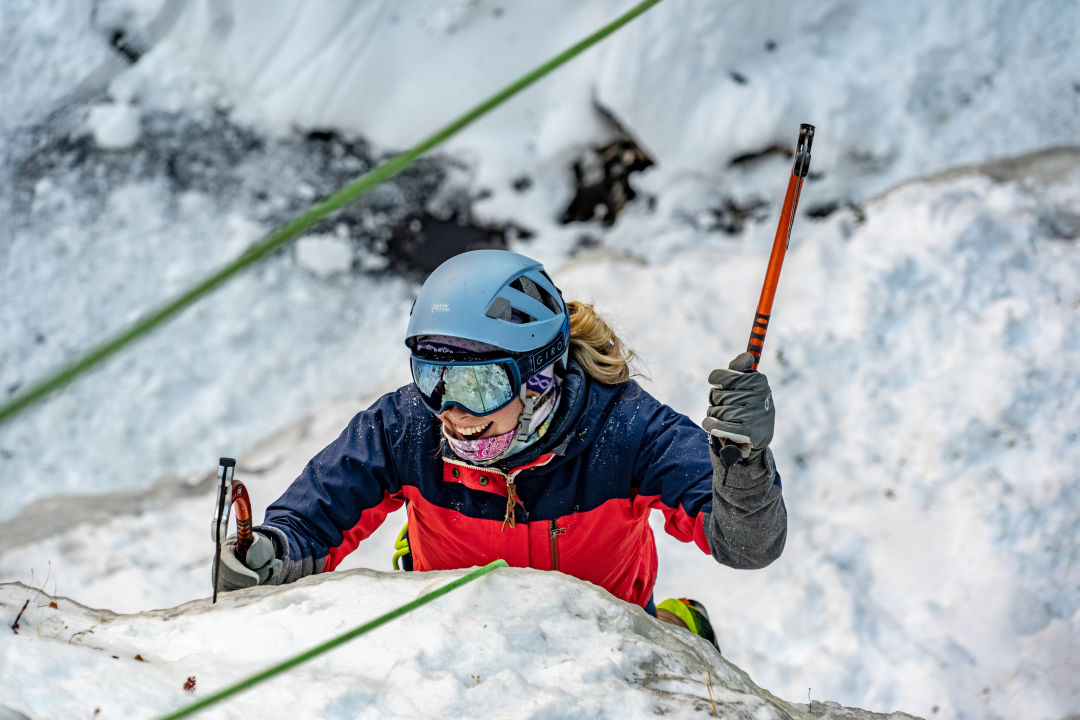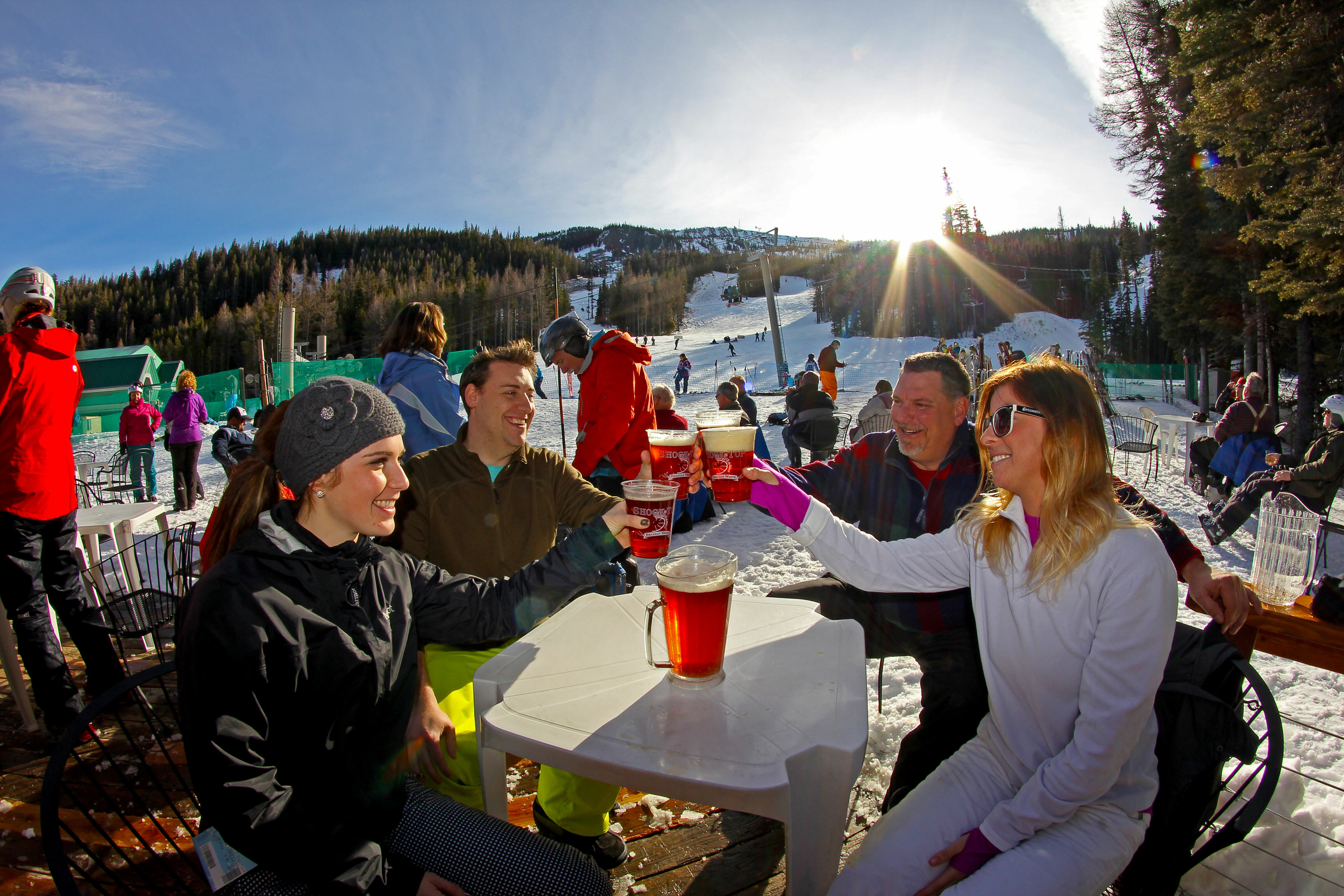Bozeman’s Frozen Waterfalls Are a Winter Playground

Climber Craig Pope ascends a route called Matriarch in Hyalite Canyon outside Bozeman.
F
ace to frosty face with a frozen waterfall, I swing my ax-shaped tool above my head. It sticks in the vertical ice with a satisfying thunk, one I can feel down my forearm. The other hand repeats the motion, only this time hooking a steel pick into a dent in the immobile cascade of ice, whose holey pockets resemble a very firm swiss cheese. Feels solid; good enough. Hanging from the tool handles like a first grader swinging from monkey bars, I kick my feet, clad in sharp crampons, into the ice below them. Once the steel talons engage an inch in, I stand.
This is how you climb a waterfall.
It’s well below freezing in Hyalite Canyon, 34,000 acres cut into the Custer Gallatin National Forest in south central Montana, but the December sunshine warms every bit of skin not swathed in down and synthetic sportswear—that is, not much. It takes a particular brand of outdoorsperson to seek a way straight up these frozen walls, but the annual Bozeman Ice Festival dedicates a week to the niche sport.
I’m in an Intro to Ice seminar, taught by experienced athletes and on ropes already secured to anchors in the trees above; we’re belayed like rock climbers as we hack our way upwards. Besides technique, instructors offer insider tips on how to manage hands and toes so cold they cause a painful sensation formally known in the snow sport community as the “screaming barfies.” It takes about half a day for a beginner to adopt the rhythm: swing, swing, kick, kick. Hand, hand, foot, foot.
Bozeman’s played host to one of the biggest ice climbing festivals in the country ever since two smaller events combined in the mid-2000s. Like rock climbing, the sport inches closer to the mainstream, even though it’s hampered by one brutal reality: Solid, predictable waterfall ice is hard to come by. Washington, for example, has snow aplenty but little smooth vertical ice beyond our remote glaciers. The west’s biggest ice climbing destination, Ouray, Colorado, depends on water spigots for reliable ice.
Enter Hyalite Canyon. The verdant valley shoots straight into the broad mountains north of Bozeman, unmarked by the patchwork of ranch parcels that make up the Montana plains. The nine-mile road that snakes up Hyalite is the longest plowed stretch in the country cleared solely for recreation—no commercial ski resort, no hotels, no snack stands. The ice climbers, along with ice fisherman and other cold seekers, are why; every year the festival helps raise the $13,000 community donation for the Hyalite plows. As the sun tucks behind the canyon walls, clinics wrap up and climbers gather around a wood campfire in the snow, housing Lit’l Smokies and handfuls of bacon as quickly as festival staff can scoop them off the grill.

Student Sarah Klintworth swings tools in a climbing clinic. Below, Lone Mountain rises above Big Sky Resort.
Think downtown Seattle could double as a Patagonia catalog shoot? Try the hallways of Bozeman’s downtown Emerson Center for the Arts and Culture during the ice festival. Be-puffed climbers, local brews in hand, cram the auditorium for films like Free Solo and circle tables of demo gear.
It’s no bro fest; more than a third of the festival clinics are women-only, and the sponsored athletes that serve as instructors include a bevy of lady climbers. The vibe is decidedly young, with most comers in their 20s and 30s, and unintimidating to those who can’t tell a front-pointed crampon from an ice ax; clinic participants can borrow everything from coats and gloves to mountaineering boots and harnesses.
Passersby do double takes at the North Face gear table, recognizing the man handing out loaner jackets as famous mountaineer Conrad Anker—known for international climbs and the Sundance-winning documentary Meru. A Bozeman local, Anker’s such a festival supporter he plays parking attendant at the Hyalite lot in the morning, chastising drivers who don’t carpool and finding ways to wedge more vehicles between snowbanks.
Bozeman is a town transitioning into the big leagues of outdoorsy destinations. Once a relatively sleepy settlement between cattle ranches and pea shoot farms, it’s grown into a mini Boulder or Jackson, offering small-town charm and kicky Western flair. Bozeman’s population has doubled since 1990; old brick storefronts now house microbreweries and restaurants dishing chia waffles and acai bowls.
The Lark, downtown’s hotel reworked from the shuttered Imperial Inn, perfectly encapsulates the town’s past and future. This sleek reimagining of a midcentury motel is a familiar sight across the U.S.—flowered bedspreads and pay-per-view replaced with Pendleton wool throws and rainfall showerheads. A map room stocked with charts of trip planning and a fireplace outside court visitors unafraid to brave the Montana chill.
Booming Bozeman may grow out and up, but in Hyalite, nature’s rhythms are as cyclical as the movements of ice climbing. An ever-morphing landscape, ever offering new challenges, as if El Capitan remade itself every year. Freeze, melt, freeze, melt—each winter’s ice a little different from the last.
Bozeman Ice Fest
December 11–15
The Lark
122 W Main St, 866-464-1000
More Bozeman Blockbusters
Museum of the Rockies
As if the Tyrannosaurus rex skeleton wasn’t enough, glass walls provide viewing access to workers that polish dinosaur fossils found deep in the Montana landscape.
Bozeman Hot Springs
In a town where the average winter temperature is somewhere between frozen car door and aching lungs, the communal series of outdoor pools fed by natural springs are less a luxury than a necessity.
Big Sky Resort
After a recent acquisition, the massive ski hill an hour from Bozeman became one of the largest in the country but remains cozy enough to have a homemade cookie and panini shop and an old-timey tram.




